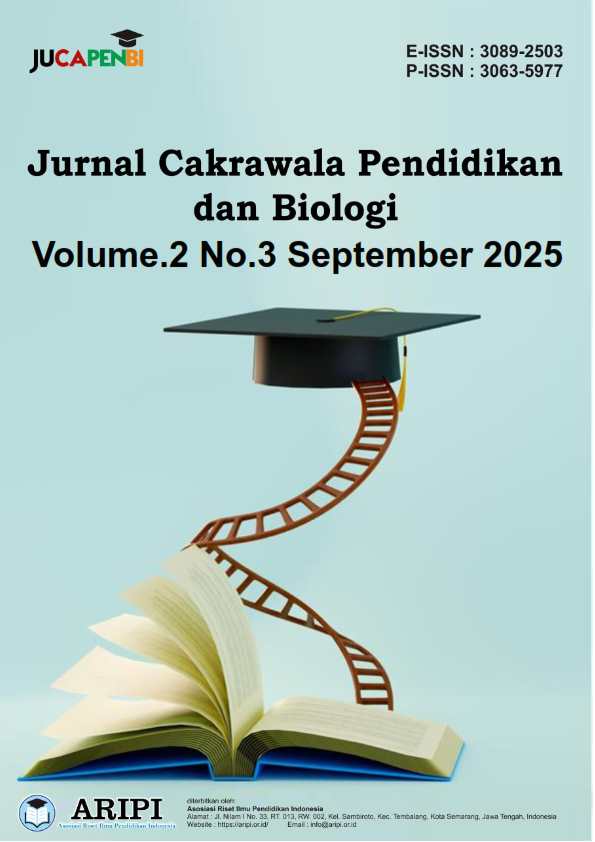Uji Efektivitas Antimikroba Dettol, Betadine, dan Harpic terhadap Staphylococcus Aureus dengan Metode Difusi Cakram
DOI:
https://doi.org/10.61132/jucapenbi.v2i3.528Keywords:
Betadine, Dettol, Harpic, Staphylococcus AureusAbstract
This research was conducted to assess the antimicrobial activity of Dettol, Betadine, and Harpic against the bacterial growth of Staphylococcus aureus using the disk diffusion technique. The method involved placing sterile paper disks soaked with each test agent onto agar media previously inoculated with S. aureus. Observations revealed that Harpic formed the widest inhibition zone, measuring 15 mm, followed by Dettol with a 12 mm zone, and Betadine with the smallest at 8 mm. Meanwhile, the control disk exhibited no inhibitory effect (0 mm). These results suggest that Harpic has the highest antimicrobial potential among the three products tested in suppressing Staphylococcus aureus growth.
References
Aminu, A. I., & Abdullahi, M. S. (2022). Evaluation of the antibacterial effectiveness of some antiseptics and disinfectants. UMYU Journal of Microbiology Research, 6(1), 175–181.
Biemer, J. J. (1973). Antimicrobial susceptibility testing by the Kirby-Bauer disc diffusion method. Annals of Clinical & Laboratory Science, 3(2), 135–140.
Fajriputri, H. (2014). Uji koefisien fenol produk antiseptik dan disinfektan yang mengandung senyawa aktif benzalkonium klorida [Skripsi, tidak disebutkan institusi].
Foster, T. J. (2002). Staphylococcus aureus. In Sussman, M. (Ed.), Molecular medical microbiology (pp. 839–888). Academic Press.
Larasati, A. L., & Haribowo, C. (2020). Penggunaan disinfektan dan antiseptik pada pencegahan penularan COVID-19 di masyarakat. Majalah Farmasetika, 5(3), 137–145.
McDonnell, G., & Russell, A. D. (1999). Antiseptics and disinfectants: Activity, action, and resistance. Clinical Microbiology Reviews, 12(1), 147–179.
Mulyadi, M., Wuryanti, W., & Sarjono, P. R. (2017). Konsentrasi hambat minimum (KHM) kadar sampel alang-alang (Imperata cylindrica) dalam etanol melalui metode difusi cakram. Jurnal Kimia Sains dan Aplikasi, 20(3), 130–135.
Pidwill, G. R., Gibson, J. F., Cole, J., Renshaw, S. A., & Foster, S. J. (2021). The role of macrophages in Staphylococcus aureus infection. Frontiers in Immunology, 11, 620339. https://doi.org/10.3389/fimmu.2020.620339
Putri, S. D., Puspitaningrum, I., & Pujiastuti, R. S. E. (2024). Efektivitas antimikroba disinfektan Eucalyptus sp. dan Melaleuca sp. terhadap Staphylococcus aureus. Al-Asalmiya Nursing: Jurnal Ilmu Keperawatan (Journal of Nursing Sciences), 13(2), 265–272.
Russell, A. D. (2002). Mechanisms of antimicrobial action of antiseptics and disinfectants: An increasingly important area of investigation. Journal of Antimicrobial Chemotherapy, 49(4), 597–599. https://doi.org/10.1093/jac/dkf037
Sumathy, V. J. H. (2016). Antimicrobial activity. Pharm Res, Indian Journal of Medicine, 4(6), 355–361.
Tong, S. Y., Davis, J. S., Eichenberger, E., Holland, T. L., & Fowler, V. G., Jr. (2015). Staphylococcus aureus infections: Epidemiology, pathophysiology, clinical manifestations, and management. Clinical Microbiology Reviews, 28(3), 603–661. https://doi.org/10.1128/CMR.00134-14
Downloads
Published
How to Cite
Issue
Section
License
Copyright (c) 2025 Jurnal Cakrawala Pendidikan dan Biologi

This work is licensed under a Creative Commons Attribution-ShareAlike 4.0 International License.






